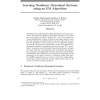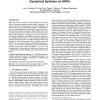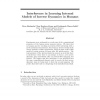595 search results - page 20 / 119 » Learning Qualitative Models of Dynamic Systems |
NIPS
1998
13 years 9 months ago
1998
The Expectation Maximization EM algorithm is an iterative procedure for maximum likelihood parameter estimation from data sets with missing or hidden variables 2 . It has been app...
KDD
2008
ACM
14 years 8 months ago
2008
ACM
Multi-core processors with ever increasing number of cores per chip are becoming prevalent in modern parallel computing. Our goal is to make use of the multi-core as well as multi...
NIPS
1994
13 years 9 months ago
1994
Experiments were performed to reveal some of the computational properties of the human motor memory system. We show that as humans practice reaching movements while interacting wi...
AIPS
2006
13 years 9 months ago
2006
We view dynamic scheduling as a sequential decision problem. Firstly, we introduce a generalized planning operator, the stochastic task model (STM), which predicts the effects of ...
ICML
2006
IEEE
14 years 9 months ago
2006
IEEE
We introduce the controlled predictive linearGaussian model (cPLG), a model that uses predictive state to model discrete-time dynamical systems with real-valued observations and v...



